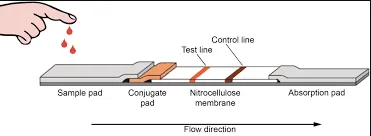
Introduction
Lateral flow assay (LFA), or lateral flow immunoassay, is a simple and rapid diagnostic technique to detect the presence or absence of a target analyte, such as an antibody or antigen, in a liquid sample. Due to its ease of use, speed, and cost-effectiveness, it is widely employed in various fields, including medical diagnostics, environmental monitoring, food safety, and veterinary testing.
Understanding Lateral Flow Assay
Lateral flow strip cutter assay works on the principle of capillary action, where the liquid sample flows along a porous membrane without any external pumping. The membrane consists of different zones, each playing a crucial role in the overall assay process.
How Does Lateral Flow Assay Work?
1. Sample Pad
The process begins when the liquid sample, usually a mixture of the target analyte and a buffer solution, is applied to the sample pad. This pad serves as the starting point for the assay and allows controlled entry of the sample into the membrane.
2. Conjugate Pad
Specific particles or beads coated with a detection agent, such as antibodies or antigens, are embedded in the conjugate pad. These particles bind to the target analyte in the sample, forming a complex that will later become visible.
3. Test Line
As the sample moves along the membrane, it reaches the test line region. This section contains immobilized antibodies or antigens specific to the target analyte. Suppose the target analyte is present in the sample. In that case, the complex formed in the conjugate pad will bind to the corresponding immobilized antibodies or antigens on the test line, forming a visible line.
4. Control Line
The control line acts as a validation marker, ensuring the assay functions correctly. It contains a separate immobilized control antibody or antigen that interacts with excess detection agents in the conjugate pad. A visible control line indicates that the test has run correctly.
5. Absorption Pad
Finally, the liquid sample reaches the absorption pad, where it is absorbed, and the assay process is completed.
Components of a Lateral Flow Assay
A typical lateral flow assay consists of the following components:
- Sample pad
- Conjugate pad
- Membrane strip
- Test line
- Control line
- Absorption pad
- Housing or cassette
Advantages of Lateral Flow Assays
Lateral flow assays offer several advantages, making them popular for point-of-care testing and rapid diagnostics:
- Rapid Results: LFA provides results within minutes, making it suitable for quick decision-making.
- User-Friendly: The assay requires minimal training and technical expertise, enabling its use in various settings.
- Portability: Lateral flow tests are usually compact, making them easily portable and deployable in remote areas.
- Cost-Effectiveness: LFA is relatively inexpensive to produce, which makes it economically viable for mass testing.
- No Instrumentation: Lateral flow assays do not require specialized equipment or instruments for analysis.
Applications of Lateral Flow Assays
Lateral flow assays find applications in diverse areas, including:
- Medical Diagnostics: Rapid detection of infectious diseases, pregnancy tests, cardiac markers, and drugs of abuse.
- Food Safety: Detection of food product allergens, contaminants, and pathogens.
- Environmental Monitoring: On-site testing for water quality, pollutants, and toxins.
- Veterinary Testing: Diagnosing diseases in animals quickly.
Limitations and Challenges
While Lateral flow strip cutterassays are valuable diagnostic tools, they do have limitations and face some challenges:
- Sensitivity: LFA may have lower sensitivity than laboratory-based techniques, limiting its detection capabilities for low-concentration analytes.
- Quantitative Analysis: LFA is mostly qualitative or semi-quantitative, which may not provide precise numerical values of analyte concentration.
- False Positives/Negatives: User error, improper storage, or cross-reactivity with similar molecules can produce false results.
- Sample Complexity: Complex sample matrices may interfere with the assay’s accuracy.
Future Developments
Researchers and developers continue to improve lateral flow assays by addressing their limitations and exploring new technologies. Some potential future developments include:
- Enhanced Sensitivity: Improving the sensitivity of lateral flow assays to detect even lower concentrations of analytes.
- Smartphone Integration: Incorporating smartphone-based detection to provide objective and quantitative results.
- Multiplexing: Developing assays that can detect multiple analytes in a single test, expanding its diagnostic capabilities.
- Lab-on-a-Chip: Integrating sample preparation and multiple assays on a miniaturized device for point-of-care applications.
Conclusion
The principle of lateral flow assay relies on capillary action and the specific interactions between target analytes and immobilized antibodies or antigens. Lateral flow assays offer rapid and user-friendly testing, making them indispensable in various fields, from medical diagnostics to food safety and environmental monitoring. As technology advances, lateral flow assays are likely to see significant improvements, further enhancing their utility and accuracy in the years to come.
FAQs
Q1: Are lateral flow assays only used in medical settings? No, lateral flow assays are utilized in various sectors, including medical diagnostics, food safety, environmental monitoring, and veterinary testing.
Q2: Can lateral flow assays provide quantitative results? While most lateral flow assays are qualitative or semi-quantitative, ongoing research aims to develop quantitative lateral flow assays.
Q3: How long does it take to get results from a lateral flow test? Lateral flow assays produce results within a few minutes, making them ideal for rapid testing scenarios.
Q4: What is the main advantage of lateral flow assays? Lateral flow assays offer rapid results, simplicity of use, and do not require complex laboratory equipment.Q5: How accurate are lateral flow assays compared to traditional laboratory tests? The accuracy of lateral flow assays can vary depending on the specific test and target analyte but is generally comparable to traditional laboratory-based methods